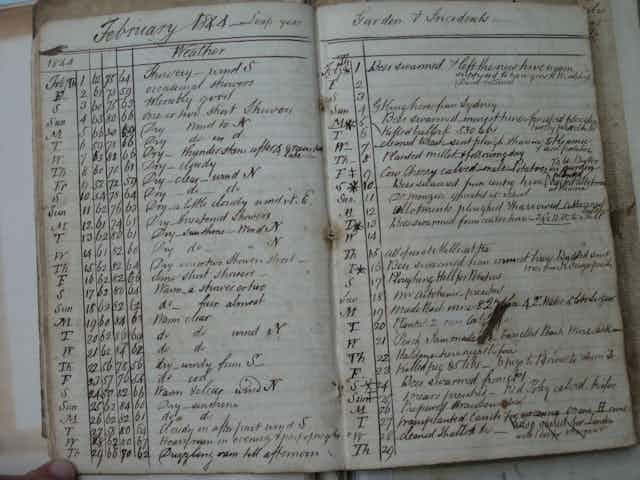To really understand climate change, we need to look at the way the climate behaves over a long time. We need many years of weather information. But the Bureau of Meteorology’s high-quality instrumental climate record only dates back to the start of the 20th century.
This relatively short period makes it hard to identify what is natural climate change and what is human-induced, particularly when it comes to things like rainfall. We really need data that go further back in time.
Natural records of climate such as tree rings and ice cores can tell us a lot about pre-industrial climate. But they too need to be verified in some way, matched against some other form of data.
So, we went hunting for some. Over two years, we looked through newspapers, manuscripts, government documents and early settlers’ diaries from Sydney, Melbourne, Adelaide and Tasmania. We took thousands of photos of letters, journals, tables and graphs. We rediscovered handwritten observations from farmers, convicts, sailors and reverends across southeastern Australia, stretching all the way back to European settlement in 1788.
Rummaging around in libraries might not seem like the best way to understand what’s been happening with our climate. But weather diaries kept by dedicated observers in the 1800s are proving important for climate research.
While there are still many observations to be rescued, the records we’ve found so far have already called into question the stability of the relationship between El Niño, La Niña and rainfall in southeastern Australia.
The records
We collected 39 different sources of weather data covering 1788–1860, with continuous observations from the mid-1830s. The numbers we’ve found so far paint a dramatic picture of the weather and climate experienced by Australia’s colonial settlers.
For example, Thomas Lempriere, who ran the Port Arthur penal settlement, recorded the harsh Tasmanian winters he suffered in the 1830s. Surgeon William Wyatt in Adelaide noted heatwaves and snowfall during the 1840s. And William Dawes, Australia’s first meteorologist, diligently observed the first drought encountered by Australia’s English settlers in 1790 and 1791.

Connecting past and present
While the observations taken by these “weather people” are valuable insights into the climate of the past, observations made more than 150 years ago are not quite the same as those taken today. Many of the instruments were not kept in the best locations. John Pascoe Fawkner, one of Melbourne’s early settlers, even stored his thermometer in a cellar!
Differences in exposure, observation techniques and instruments also mean that it’s difficult to use these observations to quantify the exact size of the temperature change since the First Fleet arrived.
However, old weather records can still tell us a lot about year-to-year climate variations. Historical rainfall observations, for example, are less prone to large biases, because rain gauges are less complex than, say, a thermometer or barometer. By using a combination of instrumental and documentary information, we can tell the story of our climate over a much longer time scale than ever before.

Australia’s climate is almost manic in its ability to swing between droughts and floods. Combining our rescued weather observations with modern data from similar locations means we can see this in southeastern Australia’s rainfall over the past 170 years.
Periods of low rainfall stand out, such as the mid-1840s, the Federation Drought at the turn of the 20th century, the World War II Drought in the early 1940s, and the Millennium Drought from 1997 to 2009. There are also clear times of high rainfall, including the 1870s, 1890s and 1970s.

Most of these periods are associated with El Niño and La Niña events: dry conditions in southeastern Australia are generally linked to El Niño, while wet years often coincide with La Niña. However, this is not always the case. Previous studies have found a breakdown in the relationship in the mid-20th century, and natural palaeoclimate records suggest a similar breakdown in the early 1800s.
Understanding these periods might help us better understand how El Niño and La Niña events might change in the future. But what do the observations from the weather people say?
We compared our historical rainfall data to previous El Niño/La Niña events and found a weakening in the relationship during 1920–1940 and 1835–1850. The breakdown was especially clear in data from the southern part of our study region. This is the first time the 19th-century breakdown has been seen in Australia using instrumental data.
The hunt continues
Of course, the next question is why? Why does the impact of El Niño and La Niña on Australian rainfall change over time? What happened in the mid-1800s? It might be El Niño’s cranky uncle, the Interdecadal Pacific Oscillation, or perhaps strange behaviour in the atmosphere around Antarctica.
We’re still not sure. But the weather observations taken by dedicated settlers more than 150 years ago are helping us answer these questions. Until then, the hunt continues.

